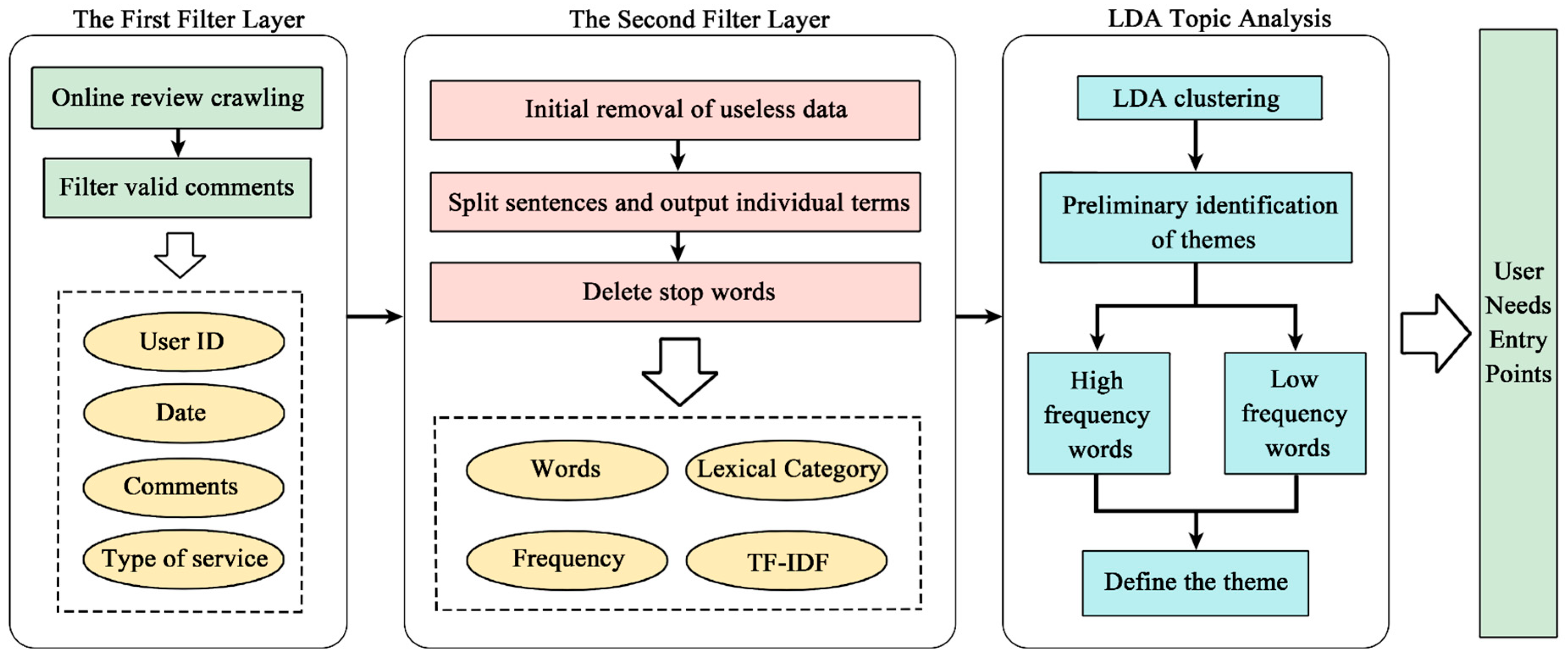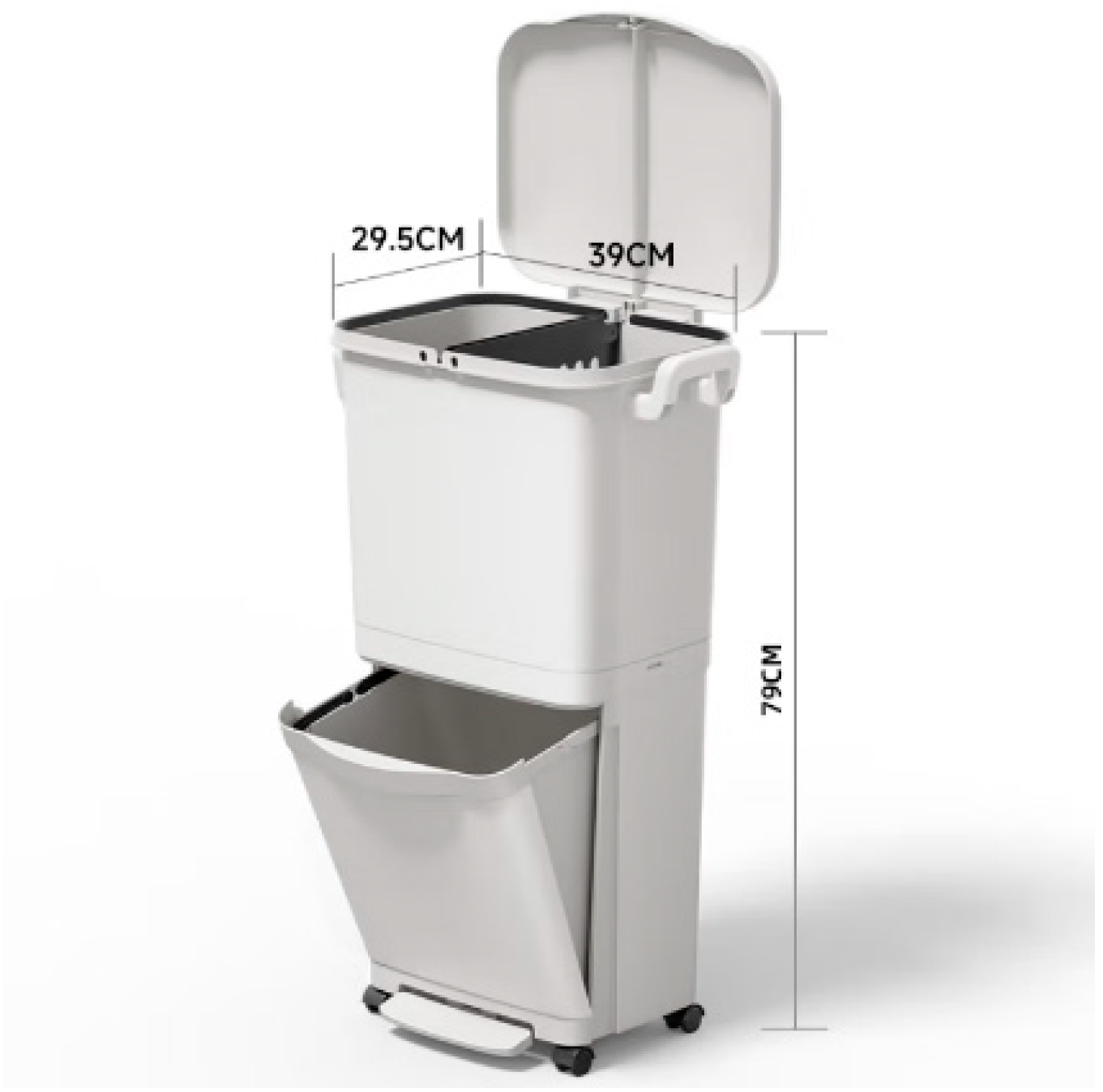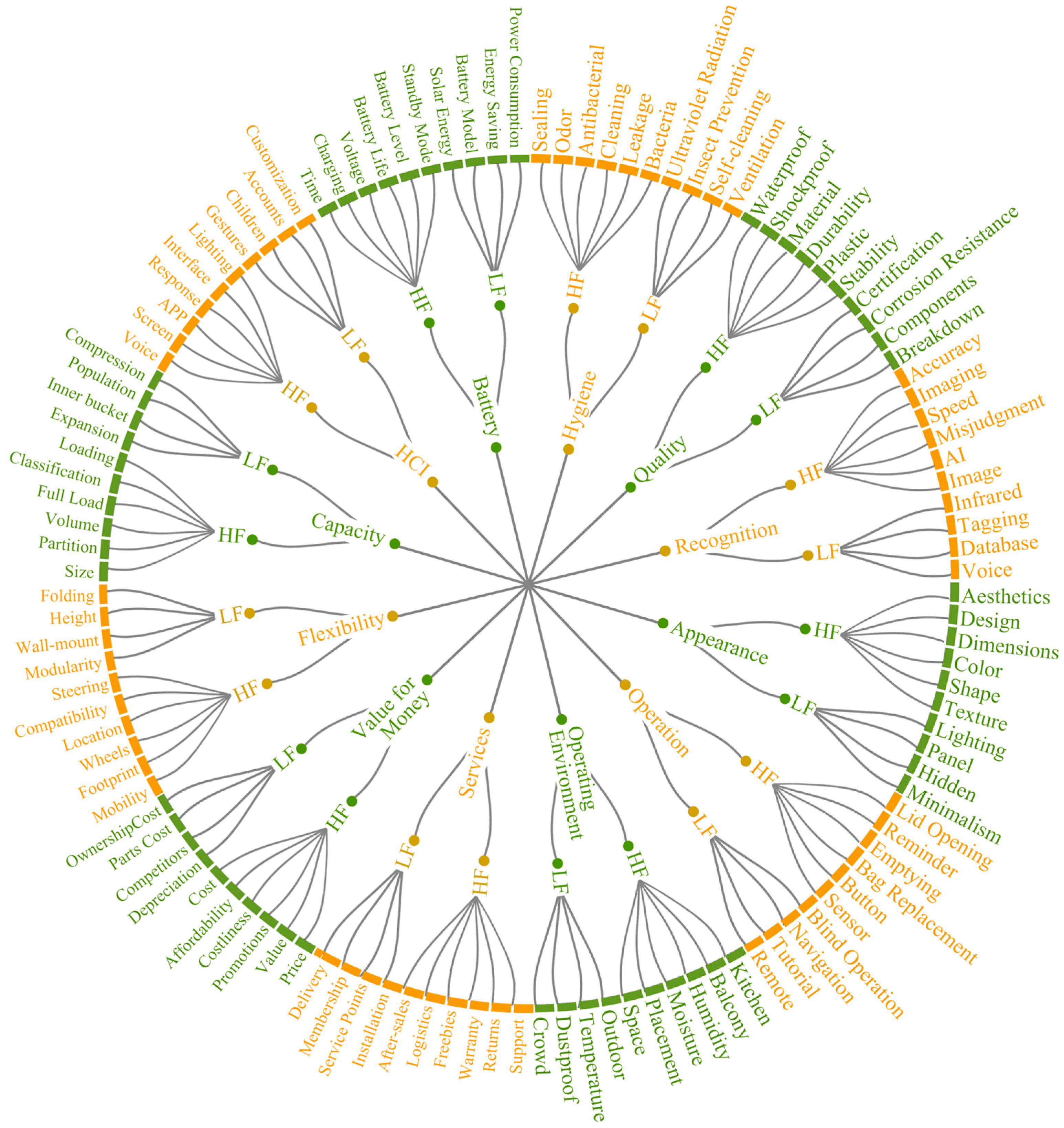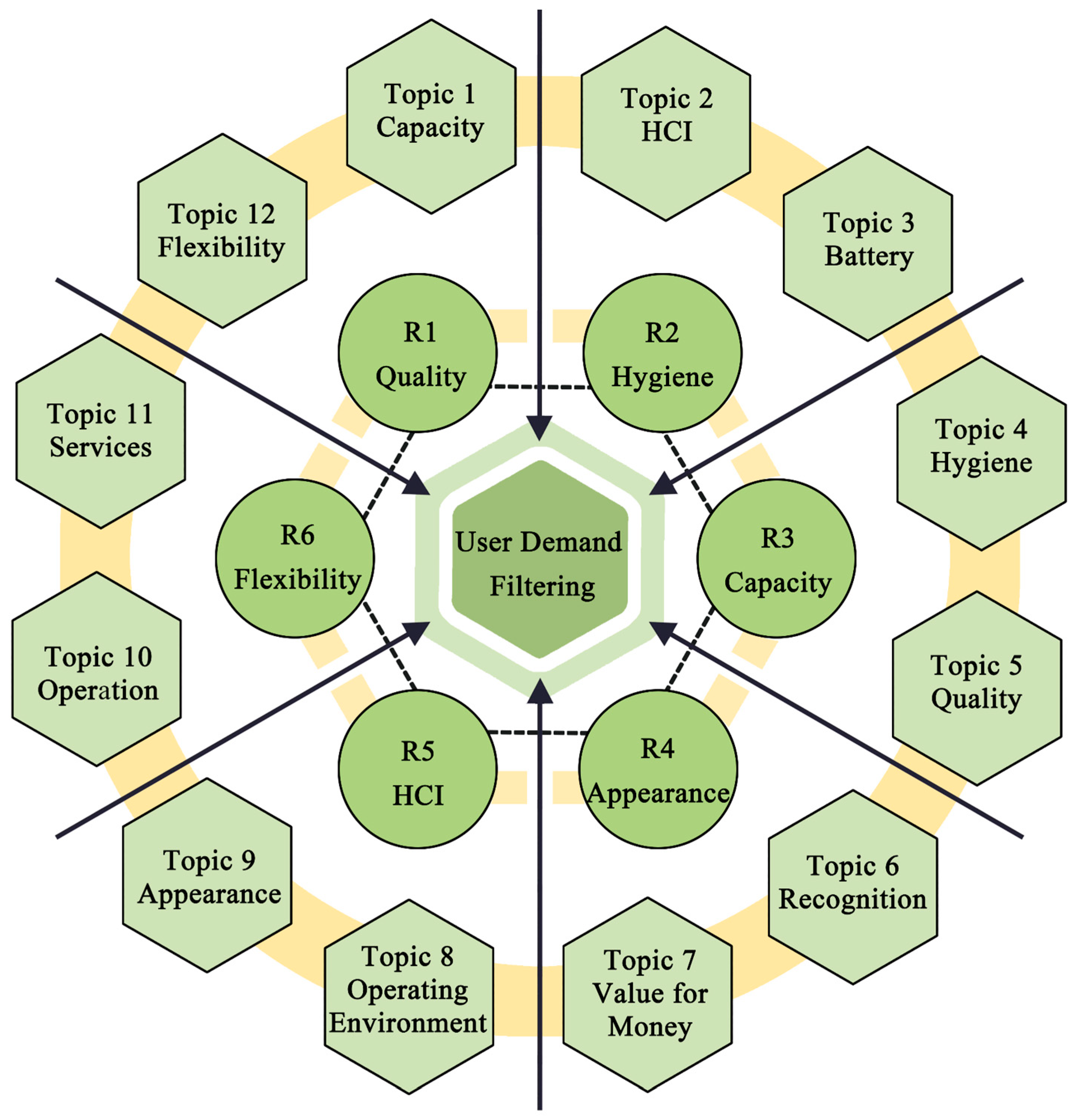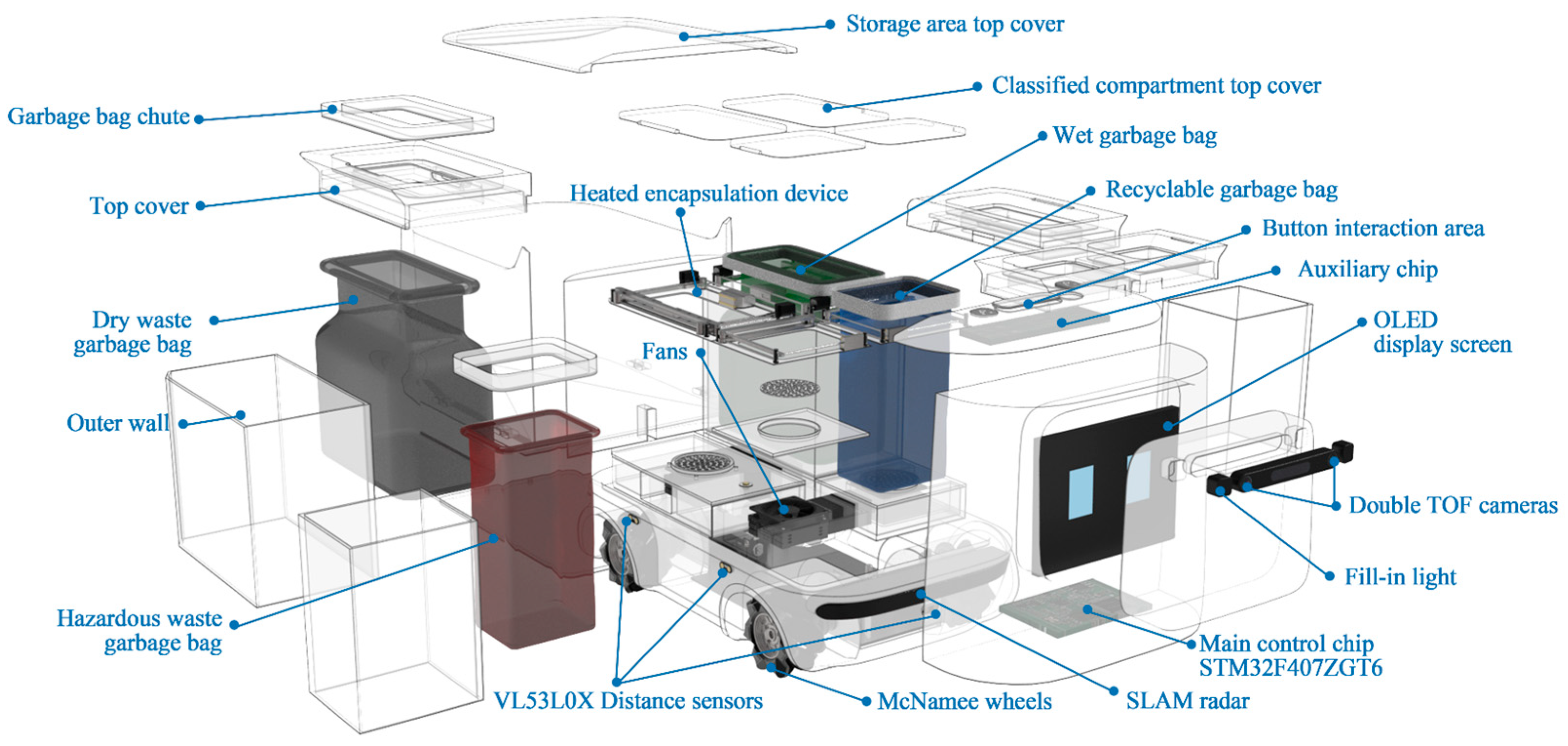3.1. Weight Determination Model Based on CHFSF
Due to the increasing complexity of decision-making environments and the limitations of human thinking, decision-makers are bound to be hesitant and ambiguous in their evaluations, and the use of fuzzy numbers in decision making can better simulate human thinking than exact values. An interval-valued hesitant fuzzy set (IHFS), as one of the important extended forms of fuzzy numbers, is able to allow decision-makers to express their preferences through multiple intervals, and is considered to be a powerful tool for expressing uncertain information in the MADM process [
51]. However, when scoring, people will inevitably have uncertainty about the scores given, but the existing interval hesitation fuzzy set does not fully consider this situation, but completely trusts the subjective judgments given by each decision-maker, which leads to a strong subjectivity in the decision-making results. Based on this, this paper combines basic uncertain information (BUI) with an interval-valued hesitant fuzzy set (IHFS), and proposes a credibility-based interval hesitant fuzzy set (CIHFS), which symmetrically integrates two key dimensions of the decision-maker’s subjective assessment: the uncertainty of the evaluation value and the level of confidence in the evaluation, as described below.
Suppose there are potential user
needs (PUNs) to be evaluated , a product with technical modules , and product assessment decision-makers .
The weighting of PUNs is , , .
The technical modules of the product are weighted , , and .
The weights of the decision-makers are , , and .
Assuming is a credibility-based interval hesitant fuzzy set (CIHFS), where represents the interval of evaluation values provided by the decision-maker and satisfies , . denotes the number of elements; represents the degree of certainty, indicating the decision-maker’s subjective confidence in their own assessment results, and satisfies .
Example: A decision-maker assigns a score of to a certain indicator using the CIHFS. It can be interpreted that the decision-maker’s assessment of that indicator falls between values and , with a confidence level of for the assigned value. The number of elements is .
- 2.
Adjustment of the weight of information for decision-makers
In current product iteration design decision making, decision-maker weights are typically assigned subjectively to reflect the relative importance of the evaluation information they provide during the process. However, the knowledge backgrounds of participating evaluators often vary, and this subjective weighting approach may undermine the scientific rigor and objectivity of the final assessment results. Specifically, subjective weighting fails to distinguish variations in the credibility of information provided by different decision-makers. Consequently, information—regardless of its reliability—is assigned equal contribution weight in the final assessment. This approach clearly undermines the formation of reliable decision conclusions.
Therefore, this paper proposes a decision-maker weight allocation method whose core logic involves quantifying quality through information credibility and adjusting decision-maker weights based on this quality assessment. The method first assumes equal weights among decision-makers. It then determines each decision-maker’s trustworthiness based on their certainty regarding the product. Following this evaluation, it proposes a method for adjusting product decision-maker weights, ensuring dynamic weighting based on information credibility. The specific adjustment approach and mathematical logic are outlined below.
Assuming
is a credibility-based interval hesitant fuzzy set (CIHFS), the decision-maker’s hesitancy [
52,
53] is defined as
where
is the variance of the interval-valued hesitant fuzzy element,
is the degree of certainty, and
is the number of elements.
When the degree of hesitation under a certain index attribute is higher under the category to be evaluated, which proves that the product evaluation decision-maker is more hesitant to make an assessment under a certain attribute, the degree of certainty of the evaluation is lower. Based on the relationship between similarity and distance, the trustworthiness of the decision-maker’s evaluation is then defined as
The decision-maker weights are adjusted according to the obtained trustworthiness to obtain more realistic decision-maker weights. The formula for adjusting the decision-maker’s weight is
where
is the weight of the decision-maker before adjustment,
is the weight of the decision-maker after adjustment, and
is the average certainty of the decision-maker.
Normalization of
yields a weight
for the final product decision-maker as
3.2. Credibility Interval Hesitant Fuzzy Score Function (CHFSF)
In practical product iteration design and multi-attribute decision-making (MADM) tasks, computational models typically require inputs as deterministic real numbers. However, the core constituent units of the CIHFS consist of one or more fuzzy interval values coupled with an exact confidence parameter, rendering them unsuitable for direct participation in subsequent operations. Therefore, it is necessary to develop a scoring function tailored for CIHFS that maps the fuzzy information and uncertainty evaluations expressed within CIHFS into computable deterministic values. This transformation is essential to meet the requirements for subsequent quantitative evaluation and priority ranking.
Based on this, this study integrates multi-source information fusion theory [
54], expected utility theory [
55], and the defuzzification concept in fuzzy decision-making to propose the credibility interval hesitant fuzzy score function (CHFSF). Structurally, the CHFSF embodies a weight symmetry mechanism between subjective information and objective references, enabling flexible control over the final precise value output through credibility parameters and decision-maker weight values.
From a mathematical logic perspective, the CHFSF first performs precision conversion on the fuzzy sets within it, then integrates various effective information, such as credibility parameters and decision-maker weights, to achieve quantitative analysis of the entire CIHFS unit. Overall, the core objective of the CHFSF is to map the fuzzy information and credibility features within the CIHFS into computable, deterministic values. This not only fulfills subsequent quantitative evaluation and priority ranking requirements but also enhances the conversion efficiency and utilization rate of fuzzy assessment information.
According to the multi-source information fusion (MSIF) theory, when the same evaluation indicator comes from more than one source, the fusion weights should be assigned according to the quality of information [
56]. In this model, the fuzzy evaluation given by the decision-maker and the system default valuation
constitute two types of basic information sources, while the credibility parameter
in the fuzzy evaluation reflects the trust level of the decision-maker’s evaluation. In order to maintain the balance of the input information, the score function designed in this paper is structured to give a symmetrical weighting relationship between the two: the fuzzy evaluation part of the decision-maker is weighted as
, and the default valuation part of the system is weighted as
, so as to make the subject–object information proportionally and equitably integrated in the confidence space.
In addition, expected utility theory (EUT) emphasizes that under uncertainty, rational decision making should be based on a weighted summation of multiple possible state utilities [
57]. The CHFSF achieves precise conversion of evaluation information in CIHFS fuzzy environments by treating decision-makers’ subjective assessments and system default valuations
as two core information sources, then performing expectation calculations based on their subjective credibility. Compared with existing fuzzy scoring functions that primarily focus on optimizing fuzzy processing while failing to establish a direct link between information quality and score calculation, and lacking a symmetric mapping mechanism between subjective and objective information, the CHFSF innovates by constructing a structured conversion framework from “fuzzy input–credibility regulation–precise output.” This framework not only maps CIHFS to quasi-exact numerical values, but more importantly, it preserves the structural flexibility and expressive adequacy of evaluation information through a credibility mechanism. This effectively reduces information entropy loss during mapping, thereby achieving symmetric logic from input to output in the information conversion process. It fills the theoretical gap in existing fuzzy scoring function methods regarding the correspondence between information types and numerical reliability.
At the operational level, this paper combines the “interval midpoint method [
58]” and “credibility weighting [
59]”, which are commonly used in hesitant fuzzy decision making, to design the following score function:
Assuming
is a credibility-based interval hesitant fuzzy set (CIHFS),
,
.
where
is the mean value of the scoring interval,
is the number of elements,
is the scoring interval synthesis operator,
is the adjusted decision-maker weight,
is the certainty-weighted synthesis operator,
is the original certainty,
is the final certainty value, and
is the default value under the lack of confidence condition, which is often taken to be 0.5, indicating a neutral reference.
The score function not only converts the uncertainty interval hesitant fuzzy expression into a unique real value but also maintains the structural flexibility and expressive adequacy in fuzzy evaluation. At the structural level, the function embodies the following mathematical and decision-making properties:
Property 1.
Range boundedness: In the CIHFS, since all interval value sets satisfy , the credibility parameters , , so
Property 2.
Monotonicity: The final value monotonically converges toward the mean of the rating interval as the credibility coefficient increases. This indicates that higher trust levels result in a greater contribution of the decision-maker’s assessment value to the final value , aligning with real-world logic.
Property 3.
Boundary properties: If , it indicates that the decision-maker’s assessment is fully credible.Then , the final value is entirely dependent on the decision-maker’s assessment. If , it indicates that the decision-maker’s assessment is completely unreliable.Then, , and the final value is entirely dependent on the neutral reference default value. The above assumptions all demonstrate the interpretability of the CHFSF under extreme scenarios.
Property 4.
Continuity and derivability: The final value is a linear function of the certainty-weighted synthesis operator . It is continuous and first-order derivable on . This ensures that minor variations in the credibility within the CIHFS induce only smooth fluctuations in the final determination value , thereby preventing abrupt changes in the final determination value results and enhancing the ranking stability of the CHFSF model.
Example: A decision-maker with a weight of
scoring an indicator as
using the credibility interval hesitant fuzzy score function (CHFSF) is calculated as
The finalized value can serve as input for technical module scoring, size comparison, weight calculation, and priority ranking. This value retains information from all decision-makers while incorporating rational system evaluation, demonstrating strong representativeness and scalability.
Considering that the simplest application scenario in the MADM after converting fuzzy information into precise real numbers is to compare the magnitudes of two fuzzy pieces of information, this paper selects two methods for converting fuzzy information into precise real numbers proposed by Quirós, P et al. [
60] and Liang et al. [
61] for comparative research. This section first briefly describes the scoring functions proposed by Quirós, P et al. and Liang et al. [
60,
61].
First of all, a scoring function proposed by Quirós, P et al. for interval hesitant fuzzy sets is designed to compare the sizes of two distinct intervals. The scoring function proposed by Quirós, P et al. [
60] is defined as follows:
For an interval-valued fuzzy set
, satisfying
,
,
denotes the number of elements, and the score function
and the accuracy function
are as follows:
Assuming two interval-valued fuzzy sets are denoted as and , and letting and be the number of elements in and , respectively, then
If , then ;
If , and , then ;
If , , and , then ;
If , , , and , and , , then .
Liang et al. [
61] define a group satisfaction function for the random MADM problem under interval-based hesitant fuzzy sets, aiming to map each complex set containing multiple interval values onto a single real number as the data input for subsequent MADM problems. The proposed scoring function is defined as follows:
For an interval-valued fuzzy set
, satisfying
,
,
denotes the number
of elements, and the steps for calculating the group satisfaction function are
as follows:
where
represents
the number of elements;
indicates
the overall level, with higher values signifying greater overall quality;
reflects
internal dispersion and group divergence; and
denotes
group satisfaction, with higher values indicating greater satisfaction with the
rating.
Example: One decision-maker with weight assigns score to a certain
indicator using an uncertain interval hesitant fuzzy set, while another
decision-maker with weight assigns score to another
indicator using the same uncertain interval hesitant fuzzy set.
Since the scoring function proposed by Quirós, P et al. and Liang et al. [
60,
61] only involves the calculation of interval numbers, subsequent comparative verification will disregard the effects of expert weighting and information credibility, setting
, and
.
According to Equations (9) and (10), it can be concluded that . Therefore, based on this method, it is evident that
the precise numerical values obtained cannot directly distinguish the relative
magnitudes of and .
According to Equations (11)–(13), it can be concluded that . Therefore, based on this method, it is equally
difficult to directly determine the relative magnitudes of and .
According to Equations (5)–(8), it can be concluded that . Therefore, based on the CHFSF method, we can directly
determine that .
As demonstrated by the above examples, under certain special circumstances, the scoring functions proposed by Quirós, P et al., and Liang et al. [
60,
61] for interval-hesitant fuzzy sets cannot achieve sufficiently scientific and precise conversion. Even when using CHFSF calculations, the average scores for both rating intervals remain equal at
. However, after
incorporating indicators such as expert weight and credibility, the precise
value results exhibit certain differences. This further demonstrates that
relying solely on information within interval hesitant fuzzy sets for precision
conversion cannot yield sufficiently objective and scientific precise values.
More critically, the two methods proposed by Quirós, P et al. and Liang et al. [
60,
61] fail to
account for expert weight contribution rates and subjective factors during
scoring. Consequently, they not only fall short of meeting CIHFS’s precise
value conversion requirements but also propagate the uncertainty inherent in
expert assessments into subsequent MADM decision making, thereby compromising
decision effectiveness.
In summary, precise conversion of fuzzy information requires not only consideration of interval values but also thorough assessment of the uncertainty attributes and reliability of expert evaluations. By symmetrically integrating these critical elements, CHFSF effectively addresses the shortcomings of traditional scoring function methods, thereby fully demonstrating its rationality and scientific validity.
3.3. CIHFS-DEMATEL Method
In iterative product design, the relationships among potential user needs need to be fully considered. Decision-making trial and evaluation laboratory (DEMATEL) is often used to analyze the correlations among metrics [
41]. However, existing DEMATEL methods typically rely on decision-makers’ provided deterministic values when assessing causal relationships among indicators. This approach not only struggles to capture the hesitancy inherent in decision-making processes and variations in assessment credibility but also fails to distinguish the contribution levels of different-quality evaluation information to the final outcome. To address this, this paper integrates the CIHFS framework with the DEMATEL method, constructing a decision-making approach that simultaneously accounts for fuzzy causal relationships and ensures structural symmetry. First, the CIHFS serves as the carrier for expressing causal strength. By utilizing “interval value sets” and “credibility parameters,” it characterizes evaluation hesitation and reliability, respectively, overcoming the limitation of traditional DEMATEL methods that rely solely on deterministic values. Subsequently, the CHFSF facilitates the transformation from fuzzy inputs to deterministic causal strengths. This process not only preserves the structural symmetry of bidirectional relationships among requirements but also assigns higher weight contributions to high-credibility evaluation information, addressing the existing DEMATEL method’s indiscriminate treatment of information quality. Finally, the transformed precise values are input into DEMATEL to construct a comprehensive influence matrix, yielding the final weight values. The CIHFS-DEMATEL process fully integrates the multidimensional logic of “fuzziness–credibility–structurality.” While maintaining symmetrical conversion between input fuzziness and output structurality, it enhances the interpretability and scientific validity of evaluation results. This provides theoretical support and methodological assurance for introducing structural symmetry into decision-making models. Based on the above approach, the corresponding attribute weight determination model is constructed as follows:
Each decision-maker scores each indicator in two-by-two comparisons using the uncertainty interval hesitant fuzzy meta form to quantify the causal influence relationship between functional elements, and each scoring value adopts a scale value of 0–1, where 0, 0.25, 0.5, 0.75, and 1.0 denote a very weak, weak, moderate, strong, and extremely strong influence, respectively, and since the DEMATEL method uses deterministic values for the calculation, the scoring of each decision-maker is completed using Formulas (5)–(8) for the scoring value of each decision-maker to do the refinement process.
After transforming the hesitant fuzzy elements of each uncertainty interval into the deterministic values used by DEMATEL, the initial direct impact matrix A is formed together.
where
denotes
the intensity of the direct effect of element
on
element
.
- 2.
Direct impact matrix data processing
The matrix A is normalized to yield the canonical matrix B.
The integrated impact matrix T is calculated. The integrated system matrix T reflects the combined effect of the influences between the elements in the system, where I is the unit matrix.
The center and cause degrees are calculated. The influence degree
and the influenced degree
of each element are calculated by Formulas (17) and (18), and the center degree
and the cause degree
of the system importance are further calculated by Formulas (19) and (20).
According to Formula (21), the center degree
and cause degree
of each indicator are combined to normalize them, the weight value of each indicator is calculated, and the weight value of each indicator is aggregated to obtain the potential user demand weight vector
